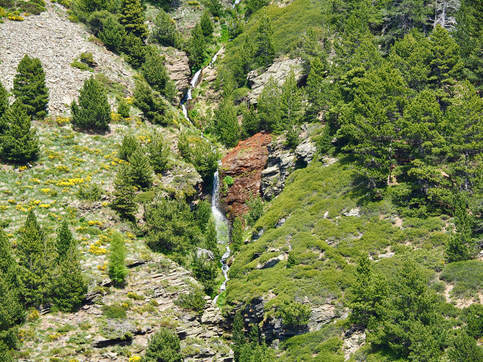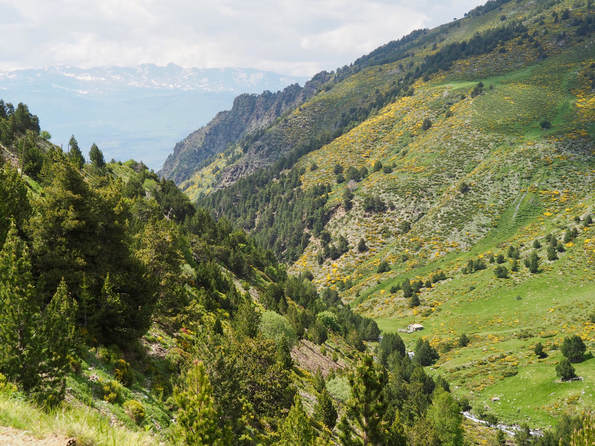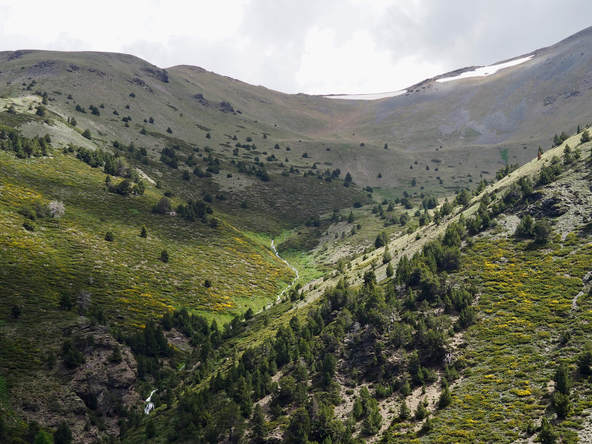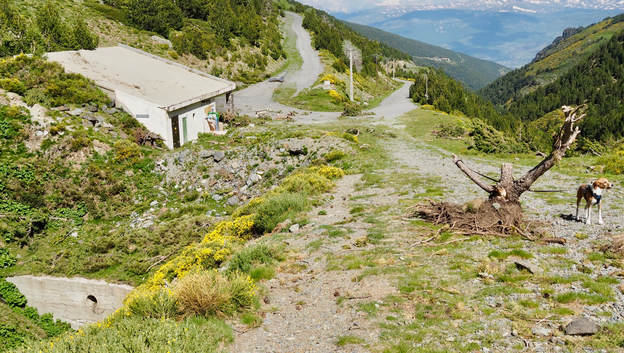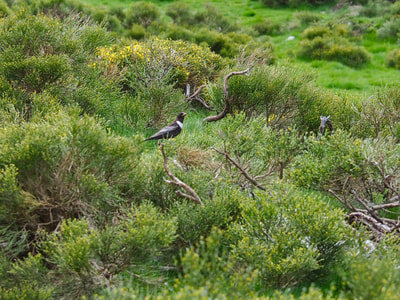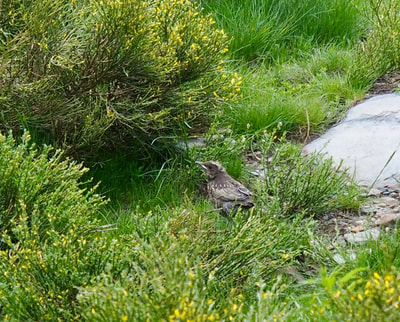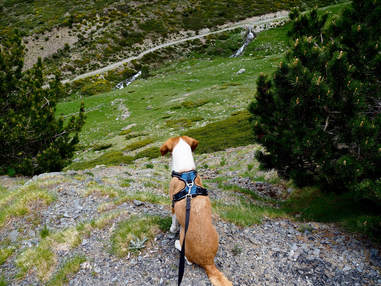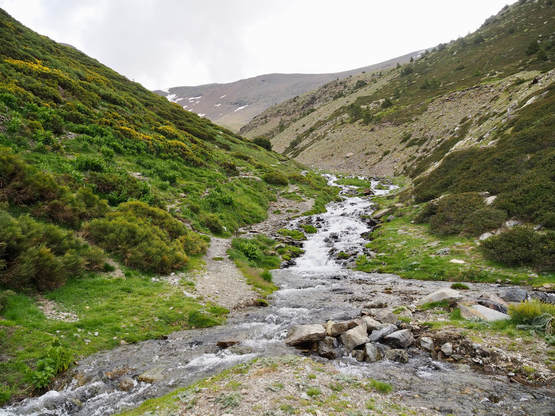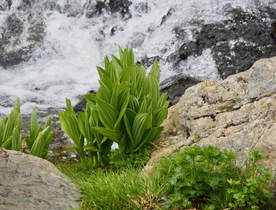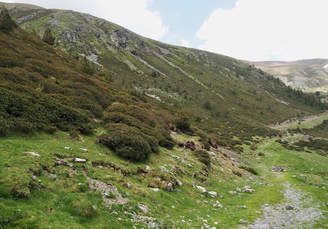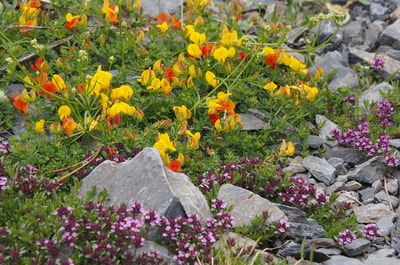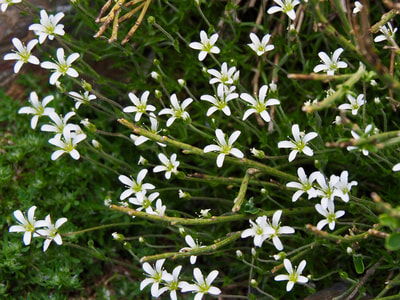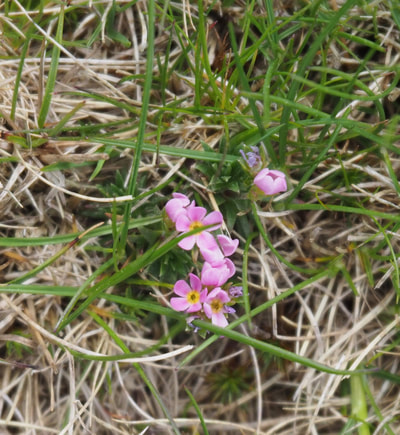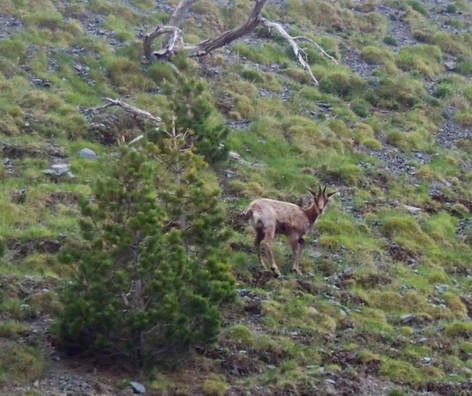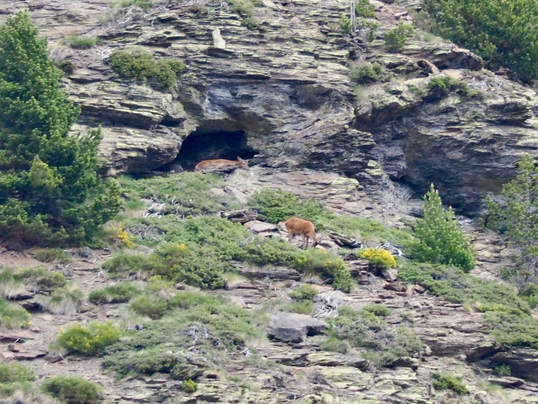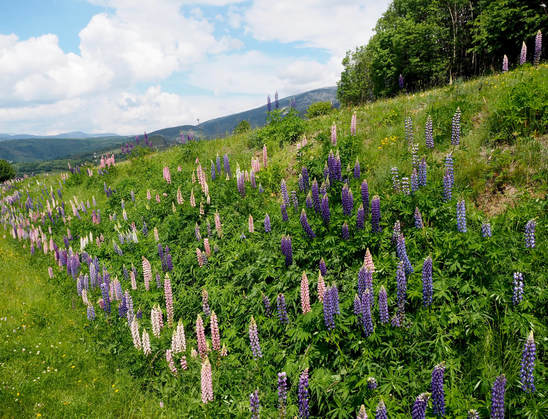June 21st. Our last full day exploring the Cerdagne and Capcir. My destination was Mt. Puigmal d'Err, which I hoped might be the high point of the whole trip for me. Figuratively as well as literally. If there weren't eagles here, where would they be?
After my recce the previous afternoon, I drove the fast route, turning off the Andorra road beyond Saillagouse and Err. As you'd expect, the road winds steadily upwards, but it's wonderfully wide as well as scenic. In winter, snow ploughs could be three-abreast. In early summer, with little or no other traffic (just the occasional cow), it was a joy.
The Err valley is steep-sided and wooded for most of the way. After about 25 minutes you pass the ski station, after which the road narrows and, a little further on, parking is obligatory - even though the road continues, according to the map. I was already slowing down when something bounded along the left-hand verge, a few yards ahead. A small dog? Briefly, I caught sight of it again before it darted sharp left and disappeared (over the edge?). A marmot.
If you start seeing creatures before you're even out of the car, it has to be a good sign, and that immediately whet my appetite for what the day could have in store. Where there's prey, there will be predators.
Even if you venture no further than the car park, the views on three sides make this a lovely spot and well worth the drive. Slopes on the opposite side of the valley have interesting rock formations, streams and waterfalls.
Like the rest of the Pyrenees, the summit of Mt Puigmal d'Err straddles France and Spain. At 2910m, It's 11m shorter than Mt Carlit and 126m higher than our own Mt Canigou. You don't get nearly such an impression of height as with our local mountain, however. I suppose this is because the approach is from a plateau that's already around 1500m, and you park at the 2000m point. Nevertheless, close-to, the glacial basin has a desolate kind of beauty above the treeline.
At the hairpin, next to a small building whose purpose I couldn't guess, it passed under the road. Uprooted conifers (many still green) were piled in and around the river on the north side of the man-made "bridge". The hairpin itself was strewn with bits of tree, rocks and rubble. It also looked as though the top layer of the building's roof had been ripped off, part of which lay yards away, up the road. Ahead, here and there on the left-hand flanks of the mountain, teardrop slashes of shale broke up the vegetation. Flattened conifers still rested on some. Perhaps a combination of violent storms, avalanches and land slips had uprooted the trees and brought many to the valley floor. After that, floods from snow melt and torrential rain swept them to the bridge, where they dammed the river until a huge surge carried them over the top and dumped most on the other side. It was sobering to picture the ferocious, churning mass of water right where we were standing now. A glance at the clouds drifting over Puigmal's summit from Spain added a small frisson. Already denser and greyer, but not really dark. Not yet.
After a few minutes a man and woman appeared from round the corner beyond it, heading towards me. Painfully slowly. The man carried binoculars so I expected him to see the ouzel, but he strolled within feet of it, apparently oblivious. Perhaps he'd seen hundreds before. I met them back on the path and we had quite a chat. Husband and wife - in their late sixties at a guess - on holiday from Bordeaux. Unfortunately I couldn't remember the French name for ring ouzel, and a rather fruitless discussion followed, with me describing it and Monsieur suggesting names, few of which I recognised. If he knew his birds, I was sure he would work out what I was on about, but he simply looked bemused. Maybe it was my bad French. Maybe he wasn't a bird watcher at all. They were very pleasant, anyway, and told me how shocked they were to find the rhododendrons still only in bud. This time last year the mountain was blanketed in red. Also this time last year, they'd been able to walk much further alongside the stream. "Don't bother going round the corner," Madame said. "The track is now the river."
I decided to continue for a bit anyway - always keen to look round the next bend. But before I got there, the ouzel appeared again, even closer, and suddenly I realised why. There was a nest here somewhere. I stood still, waited, and watched as it swooped to the ground between bushes only a few feet from me. And, oh my goodness, it hadn't flown to a nest but to a fledgling, which it promptly fed!
They must be very hardy birds. Our chalet host had told us that only three weeks before our arrival, there was heavy snow on the plateau. It would have been much worse up here, yet at least one young ouzel had survived. My book says they have two broods (5 or 6 eggs in each) April to June. And they like nesting in "steep banks, rock cavities or fallen stone walls". My observation post among the boulders might have been the perfect spot!
After pausing to take a couple of photos, I turned round and headed back before I disturbed them any more or there was a tragedy. Siblings might be around too, and if they were like normal blackbird fledglings they would be running rather than flying. It was quite possible that one would run straight into Digby's path at any moment; he can snatch things up horribly quickly, even when he's on a short lead.
Click pictures to enlarge image
After leaving them again, I was a bit disappointed to have to regain the road, but it did mean that progress uphill was swift and easy. The tarmac was more broken up by now, with a lot of shale on the edges, studded with flowers. Mini rockeries. A few butterflies visited them, but nothing out of the ordinary.
After the next hairpin, we were heading south again, roughly parallel with the river but much higher above it. Below, the Bordeaux couple hadn't made much progress at all. I'd noticed them standing still for some time, facing our direction, so I waved but they didn't respond. Perhaps they weren't looking at me, but something lower down. My dog had certainly caught sight or scent of something and was pulling me towards the edge. Marmots, directly below us! This was a whole new potential snack for him, and he sat down, ears forward, mightily curious.
Several of them were lounging around and grooming, but two had a wonderful game, chasing and leaping on each other; rolling on their backs and having mini boxing matches. I last saw them doing that at the Batère when I was with Robin, several years ago. This time I managed to film them - albeit from a long way off.
Marmots At Play from Lesley McLaren on Vimeo.
At the third hairpin I left the road once more, and struck diagonally across a patch of short grass and rocks - to a track that led to the river and continued the other side, into the bowl of the mountain. Another bend beckoned. But the water would have come well over my boots and was too wide to step over. I would have to take a running jump to clear it, and wasn't sure that was a good idea with a dog on a leash. What if Digby didn't jump with me?
My sandwiches went down a treat and we were slowly retracing our steps towards the road, when two young women appeared from nowhere. With an enviable lightness of step, they crossed our path and struck off, at impressive speed, up a steep, narrow track through the rhododendrons. Rather them than me, if they were heading for the summit. If our presence was remarked at all, we would have been tagged "the snail-paced Anglaise and her dog."
I'd just creaked upright after taking photos of some blue gentians and a tiny pink flower almost hidden in the grass, when a pair of grey wagtails caught my eye. I'm used to seeing them flit from rock to rock, but these put on a beautiful display, flashing bright yellow as they spiraled up and down, intertwined, in an elegant dance. They were the first birds I'd seen since the vulture. All the eagles, I decided, were over at the gorges du Sègre.
Seeing large mammal species like this was one of my wishes come true for the trip - and perfect compensation for the lack of raptors.
To my surprise, when I scanned a smaller, more distant cave, I realised an animal was lying in it. No bear or lynx, obviously, but something quite big. A deer? By happy coincidence, the cave turned out to be directly opposite where I'd parked the car, so, about half an hour later, I confirmed my suspicion.
I found Robin and Martine at the parking spot too, having a snooze in their van. I knew they'd planned to come here at some point in the day, and guessed they'd already had a walk. Not wanting to disturb them, I sat and kept watch on the cave for some time. Hard to see anything with the naked eye, but the doe was quite clear through binoculars. When an isard ambled past her, she didn't move other than to lift her head for a few seconds. She was still there when my friends emerged, and Robin remarked on how unusual it was to see a red deer all on its own, when you can hardly move for them in the Scottish Highlands. Eventually, perhaps because evening approached and it was cooler, she got up. With no need for haste, she gradually picked her way through the rocks, stopping here and there to nibble at something, before slipping out of sight in the scrub.
